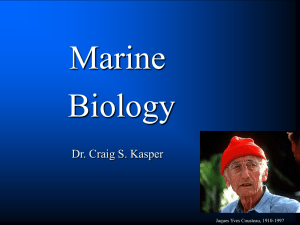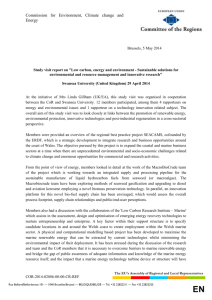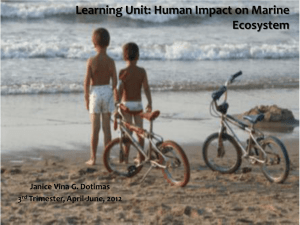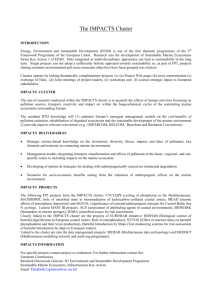Rathlin Island European Marine Site Management Scheme
advertisement
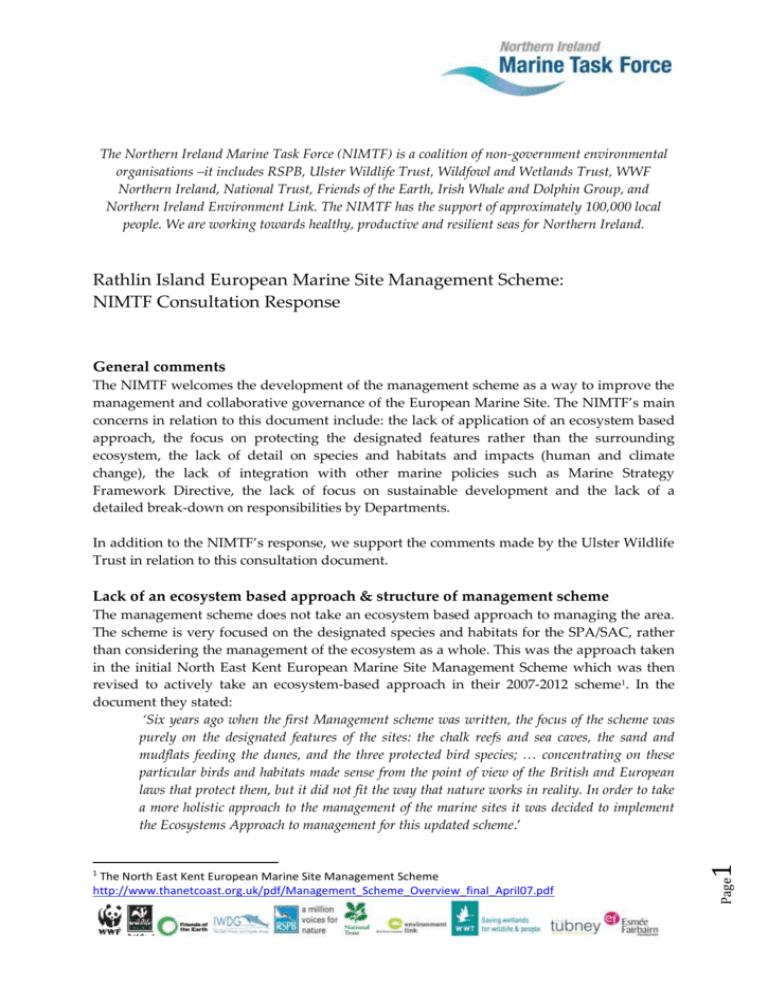
The Northern Ireland Marine Task Force (NIMTF) is a coalition of non-government environmental organisations –it includes RSPB, Ulster Wildlife Trust, Wildfowl and Wetlands Trust, WWF Northern Ireland, National Trust, Friends of the Earth, Irish Whale and Dolphin Group, and Northern Ireland Environment Link. The NIMTF has the support of approximately 100,000 local people. We are working towards healthy, productive and resilient seas for Northern Ireland. Rathlin Island European Marine Site Management Scheme: NIMTF Consultation Response General comments The NIMTF welcomes the development of the management scheme as a way to improve the management and collaborative governance of the European Marine Site. The NIMTF’s main concerns in relation to this document include: the lack of application of an ecosystem based approach, the focus on protecting the designated features rather than the surrounding ecosystem, the lack of detail on species and habitats and impacts (human and climate change), the lack of integration with other marine policies such as Marine Strategy Framework Directive, the lack of focus on sustainable development and the lack of a detailed break-down on responsibilities by Departments. In addition to the NIMTF’s response, we support the comments made by the Ulster Wildlife Trust in relation to this consultation document. Lack of an ecosystem based approach & structure of management scheme The North East Kent European Marine Site Management Scheme http://www.thanetcoast.org.uk/pdf/Management_Scheme_Overview_final_April07.pdf Page 1 1 The management scheme does not take an ecosystem based approach to managing the area. The scheme is very focused on the designated species and habitats for the SPA/SAC, rather than considering the management of the ecosystem as a whole. This was the approach taken in the initial North East Kent European Marine Site Management Scheme which was then revised to actively take an ecosystem-based approach in their 2007-2012 scheme1. In the document they stated: ‘Six years ago when the first Management scheme was written, the focus of the scheme was purely on the designated features of the sites: the chalk reefs and sea caves, the sand and mudflats feeding the dunes, and the three protected bird species; … concentrating on these particular birds and habitats made sense from the point of view of the British and European laws that protect them, but it did not fit the way that nature works in reality. In order to take a more holistic approach to the management of the marine sites it was decided to implement the Ecosystems Approach to management for this updated scheme.’ The NIMTF would recommend that a similar approach be taken by the Department for the Rathlin European Marine Site management scheme. The North East Kent Management Scheme recognised the ecological importance of other non-designated features and the need for a management plan to consider these aspects of the system. This scheme was also developed by their management group with stakeholder engagement workshops. These identified both the different values that people had for the area, as well as the perceived threats/issues affecting the ecosystem. We appreciate that stakeholders may have been approached by the Department prior to drafting this document, and that the proposed EMS Management Group will be involved in shaping the management approach, however the NIMTF believes that the Management Group should have been convened before development of the draft scheme. This is a crucial factor, as it would have enabled an ecosystem based approach with early, transparent stakeholder engagement to identify collective values, concerns and objectives for the scheme. Without the prior existence of an EMS Management Group, the Management Scheme does not appear to reflect a full range of stakeholder views. Successfully implementing an ecosystem based approach involves engaging early and effectively with stakeholders and allowing them to be part of the planning and decision making process. It would strengthen the management plan if it were structured in a way that followed the principles of the ecosystem approach. This would involve beginning the scheme document with a clear explanation of the ecological, social and economic values for the site and surrounding area/ecosystem. We would suggest that the French Government’s approach to marine site management plans is very user-friendly and clearly lays out the different uses and values of the sea before discussing the objectives of the plan and the possible threats and action plans 2 . It includes maps, with species and habitat distributions, as well as spatially mapping human activities such as fisheries. In the draft document it is also important that the objectives are clear and simple and set out together, as the current draft document has a range of aims and objectives which appear on different pages. For example, aims for the management scheme (page 18) and then management objectives (page 27) conservation objectives, social/economic objectives, specific conservation objectives (page 28). Ideally, all these different objectives should be synthesised into one series of short over-arching objectives (with additional sub-objectives included if necessary). As they currently stand, we would make the following suggestions in relation to each of the objectives: In our view the management scheme objectives should adopt the ecosystem based approach and read as per the following. To protect the features of interest for which the site was chosen and the wider ecosystem. Page Marine Park Management Plan- Iroise http://www.airesmarines.fr/publications/plan_gestion_iroise/finalites_gestion/index.html 2 2 To collaboratively manage the site using an ecosystem based approach that enables sustainable development and ecosystem health. To promote public awareness of the marine ecosystem around Rathlin Island, including the conservation benefits, potential threats (human and climate change) and the need for sustainable use and development. To promote sustainable development that is consistent with maintaining and improving the European Marine Site. The conservation objectives should read: The site’s natural habitats and species of interest should be maintained at Favourable Conservation Status (FCS) and the surrounding ecosystem enhanced where possible, and steps should be taken, where required, to avoid any disturbance to species and habitats either designated under the directives or of national or ecological importance. The spatial protection measures will be consistent with achieving Good Environmental Status under MSFD for biodiversity of habitats, species and food webs. The site will contribute to an ecologically coherent network of sites at both Northern Ireland, UK wide and bio-geographic scales. The relevant authorities should assess activities, plans or projects in or outside the site that may have a significant effect on the features for which the site was declared. A monitoring programme should be established to assess the state of the site and the effectiveness of the management measures.(This should link to MSFD monitoring programs) The relevant authorities and stakeholders should work together within a management group or forum to develop a management scheme. The management scheme should be incorporated into the statutory framework such as the local and regional plans. (and the marine spatial plan) NB: The NIMTF believes that the word ‘enhanced’ should be used above to give it equal standing with the socio-economic objectives. Page 3 The socio-economic objectives should read: Sustainable development will underpin all development and use of the EMS site and the wider ecosystem around the site in a manner which is consistent with the conservation objectives. The promotion and development of local businesses, which can benefit from SPA and SAC designation, and the marine biodiversity of the wider ecosystem should be encouraged. This could be supported by the North Coast Marine Ranger. The local stakeholders and the statutory authorities should work together as much as possible within the structure of an EMS Management Group, to maintain the interests and the inherent potential in the two management objectives. There should be efforts to raise awareness of the EMS, the benefits of marine conservation generally and to attract funding as appropriate for future sustainable development of the site. Consultation Question 1: Does the overall draft Management Scheme contain an appropriate level of detail given the scope of the issues? The NIMTF suggests that the document requires additional information to strengthen it, and that there is currently an insufficient level of information given the scope of the issue. Below are our suggested improvements to the document: Joining up the management scheme to UK/ EU/ international commitments & legislation. The document is focused on fulfilling objectives under the Habitats and Birds Directives, and should be more joined up with other relevant policies. It would be beneficial to add in how the protection management of this site relates to the EU Marine Strategy Framework Directive (protecting biodiversity, food webs) and relates to contributing towards an ecologically coherent network of sites. This would also provide the opportunity for linking this management scheme to furthering an ecologically coherent network of properly managed and enforced sites for NI (and wider UK). This is particularly relevant for the migratory bird species found on Rathlin, whose feeding, breeding and maintenance activities should be managed and protected as part of an ecologically coherent network. Page The technical language should be explained, or simplified, and supplemented by images, maps, diagrams and tables. Otherwise this description does not add much to a reader’s understanding of where the habitats and features are located, and how that relates to spatial boundaries of the protected areas or human activities. It is particularly important that the management scheme includes this spatial information for both designated and nondesignated (but ecologically important) features and that it also includes spatial information of where human activities occur (or are planned such as renewable/oil exploration). We suggest that diagrams and maps be used to describe all the SPA/SAC features and additional features of ecological importance. In particular we suggest that maps be created 4 Information on designated features & other ecologically important features of the site Additional information is required on the designated features. In particular, the description of the EU features is overly technical for a document for public consumption. For example: “Strong tidal streams prevail around most of the island, and there is little silt. As a result, turbidity is generally low, with the infralittoral extending below 20 m depth, and water temperatures are stable, not rising much above 13ºC in the summer... Along the south-west coast there is a very steep slope of large, stable boulders extending below 50 m in places. The boulders support biotopes dominated by the hydroid Tubularia indivisa in deeper water and by a diverse assemblage of algae in the shallows.” showing the distribution of seabirds (designated species and non-designated species) across the cliffs, and additional information of how they use the marine component of the site. For example Chivers et al. 20123 is a useful reference for kittiwake movements from Rathlin Island, and this more broad ecological consideration would assist in taking an ecosystem based approach. Chivers, L. S. et al. Foraging trip time-activity budgets and reproductive success in the black-legged kittiwake. Mar Ecol Prog Ser 456, 269–277 (2012). Page 3 5 An example of an effective species map for marine management plans is the French Government, Marine National Park management plan. Migratory species distribution map. http://www.aires-marines.fr/publications/plan_gestion_iroise/finalites_gestion/index.html Page 6 An example of an effective habitat map for marine management plans is the French Government, Marine National Park management plan. http://www.aires-marines.fr/publications/plan_gestion_iroise/finalites_gestion/index.html Inclusion of SPA bird maintenance activity boundaries- JNCC advice. In relation to the SPA component of the EU Marine Site, the NIMTF is concerned that the Management Scheme does not address any additional extension to the SPA boundaries for bird ‘maintenance activity’ as Rathlin Island is one of the sites identified by JNCC for bird colonies requiring extension, which was also agreed jointly by UK administrations. Rathlin Island SPA is identified under 4.2 of the Directive for its assemblage qualification: ‘a seabird assemblage of international importance including the area regularly supports 66,000 individual seabirds including: Puffin Fratercula arctica, Kittiwake Rissa tridactyla, Herring Gull Larus argentatus, Lesser Black-backed Gull Larus fuscus, Common Gull Larus canus, Fulmar Fulmarus glacialis, Razorbill Alca torda, Guillemot Uria aalge.).’ According to JNCC advice 4 the extensions for relevant species around Rathlin Island would be: Puffin (1km) Razorbill (1km) Guillemot (1km) Fulmar Fulmarus glaciais (2km) The NIMTF does not think that the Management Scheme’s statement is sufficient, as it states: ‘The extension includes an area of sea around the island which is used by many of the seabirds which breed around the island's coast. This marine area is used by the seabirds for purposes of display, loafing and preening as well as some feeding although the seabirds breeding at Rathlin can travel considerable distances for the purpose of feeding’. The Department’s approach in relation to this issue needs clarification and the Management Scheme should outline the timeframes in relation to when the maintenance activity extensions will be implemented. More detailed information on island life and current activities (pg.25) The NIMTF believes that this management plan should adopt an ecosystem based approach and that therefore more detail needs to be provided on the human values and activities taking place around Rathlin. This would also include a discussion of the maritime archaeology and heritage, and the need for preservation of these features. This joined up type of thinking is really important, as the cultural aspects of Rathlin Island are part of the ecosystem and will also play a role in bringing (sustainable) tourism to this area. For an example, see the French Management Plan map for the marine national Park Iroise. http://jncc.defra.gov.uk/pdf/comm05P14B.pdf Page 4 7 An example of an effective cultural heritage map for marine management plans is the French Government, Marine National Park management plan. In relation to oil exploration by Providence and renewable energy, this should really appear in a different subsection (ie. future development activity/ energy developments). It should also be accompanied by maps showing the areas being explored for oil & the tidal project leases. The information in the current draft document is out of date in relation to the tidal energy projects, as the Crown Estate has already granted a lease to DP Energy Marine/DEME Blue Energy to explore off Fair Head and Tidal Ventures off Torr Head. Detail of public authority responsibilities The Governance structure in Northern Ireland for marine issues is very complicated. Whilst the NIMTF welcomes the inclusion of tables under each ‘current operations that have the potential to be damaging to features of the EMS’ to summarise the responsibilities for the various public authorities involved in Rathlin Island EU marine site, it would be strengthened by additional detail. For example, the information on DARD’s responsibilities is too general, as each entry simply states ‘responsible for agriculture, inshore fisheries management, policy and regulation’. Additional details could include that DARD/AFBI are developing/releasing an inshore fisheries strategy. It is important that the strategy and the management scheme are joined up. Page Detail of threats/pressures. The list of potentially damaging activities is not sufficiently detailed. The list of potential activities or threats should include threats that are relevant under the MSFD. The 8 It would also be good to begin the management scheme with a diagram to explain the interactions between each public authority in dealing with the management scheme. responsibility for Good Environmental Status under MSFD should be included in the table outlining public authority responsibilities. In addition to the outlined ‘threats’ there should be separate sections for MSFD indicators which should have separate sections include noise/energy, litter, eutrophication and invasive species. Furthermore, more detail is required on the range of recreational activities taking place around Rathlin, as the current draft lists only ‘boating activity, bird watching, walking’. When there are many different activities such as jet skiing, coasteering etc which take place around Rathlin. In each section that considers human activities this should also consider how management of the activity integrates into the future NI Marine Plan. Furthermore, most notably absent from the entire document is consideration of climate change as a threat to species and habitats. Consultation question 2: Are there any existing issues/measures which you think are not outlined in the document and which should be included? This has been largely answered throughout the response to Question 1 and in the general comments. However below are a summary of the most critical gaps in the management scheme. The lack of an ecosystem based approach needs to addressed and the scheme needs to reflect this approach throughout. Climate change and its impact on the habitats/species and the ecosystem (including human aspects) needs to be included as a major pressure on the conservation objectives of the EMS. The structure and functioning of the EMS management group needs to be addressed including how decisions are made/finalised around the table. The management scheme should provide additional guidance on how decisions by the EMS should be balanced by sustainable development principles and an ecosystem approach. Marine heritage and archaeology needs to be considered. Linkages need to be made with the Marine Strategy Framework Directive and with the SAC/SPA being part of a future ecologically coherent network of MPAs. Concluding remarks The NIMTF is pleased to have the opportunity to comment on the Rathlin Island EMS Management Scheme. We believe that it needs to take a much broader, ecosystem-based approach that is integrated with EU and UK existing policies for marine management. We think that it will be considerably strengthened by this approach. Page 9 Please feel free to contact Marguerite Tarzia (NIMTF Technical Officer) to discuss any of the points we have raised. For further details please contact the NIMTF Email: info@nimtf.org Marguerite Tarzia- Marine Technical Officer: 0773 069 1391; marguerite@nimtf.org Page 10 Richard Devlin- Marine Campaign Co-ordinator: 0772 557 3692




